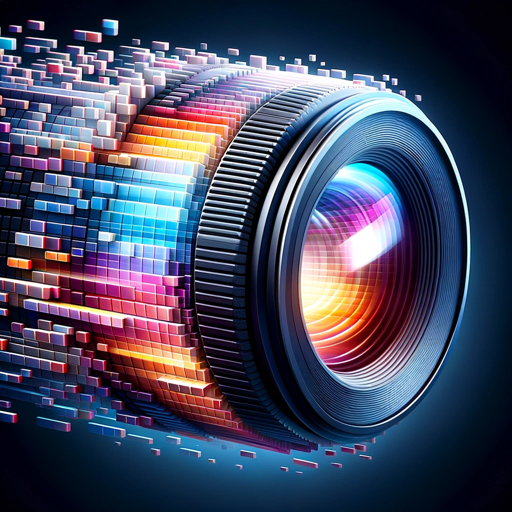Image Enhancer-AI image enhancement tool
AI-powered image enhancement made easy.
Can you enhance this group photo?
Make this old picture clearer, please.
I'd like this blurry image sharpened.
Is this photo too pixelated to fix?
Related Tools
Load More
Image Upscaler & Enhancer
Improves the image quality of old and blurred photos in seconds 🖼️✨ Ideal for face restoration. This GPT uses the latest AI technology to help you achieve high-resolution upscaling 100% free!

Advanced Image Upscale, Restoration & Enhancement
Expert in automatic photo editing for optimal image enhancement.

Image Enhancer Pro
Analyze an image, describe it and create an image with the description with Dall-E 3.
Image Copy Machine 👉🏼 Auto-improve version
The best image copying tool. Works as an img2img machine that will auto describe any jpg, png or svg file, and recreate it. You can modify the style and blend images.

Image Enhancer 4K
Upscales images to 4K resolution, focusing on quality improvement.

Auto Improve Image
Let's improve your image into something really wild. Upload an image and let's go!
20.0 / 5 (200 votes)
Introduction to Image Enhancer
Image Enhancer is designed to improve the quality and aesthetics of personal photographs through a user-friendly interface. It leverages advanced AI technology to perform a variety of enhancements, making images look more professional and visually appealing. The purpose of Image Enhancer is to provide a seamless and approachable way for users to enhance their photos, whether for personal enjoyment, professional use, or social media sharing. Examples of its application include improving family photos by correcting lighting and color, making travel photos more vibrant by enhancing details, and refining portrait shots for a polished look suitable for LinkedIn profiles or portfolios.

Main Functions of Image Enhancer
Automatic Enhancements
Example
Adjusting brightness, contrast, and color balance
Scenario
A user uploads a poorly lit vacation photo. The automatic enhancement function adjusts the lighting and colors to make the image appear bright and vivid, as if taken under perfect conditions.
Portrait Retouching
Example
Smoothing skin, removing blemishes, and whitening teeth
Scenario
A professional needs a high-quality headshot for their LinkedIn profile. The portrait retouching function smooths out skin imperfections, enhances eye clarity, and whitens teeth, resulting in a polished and professional appearance.
Background Removal
Example
Extracting subjects from backgrounds and replacing them with new ones
Scenario
An e-commerce seller wants to showcase products against a clean, consistent background. The background removal function isolates the product and allows the user to place it on a white or custom background, enhancing the product's visual appeal and consistency across the catalog.
Ideal Users of Image Enhancer
Social Media Enthusiasts
These users regularly post photos on platforms like Instagram, Facebook, and Twitter. They benefit from Image Enhancer by improving the visual quality of their photos, ensuring their posts stand out and attract more engagement.
Professionals and Business Owners
This group includes individuals who need high-quality images for professional profiles, business websites, or marketing materials. They use Image Enhancer to create polished and professional visuals that enhance their personal brand or business image.

How to Use Image Enhancer
1
Visit aichatonline.org for a free trial without login, also no need for ChatGPT Plus.
2
Upload the image you want to enhance directly on the website. Supported formats include JPEG, PNG, and TIFF.
3
Select the desired enhancement options such as resolution improvement, color correction, or noise reduction.
4
Preview the changes in real-time and adjust the settings until you are satisfied with the result.
5
Download the enhanced image in your preferred format. Ensure you save the file to a secure location for future use.
Try other advanced and practical GPTs
Worldwide Trends Assistant
AI-Powered Trends Analysis

PDF to WORD (docx) Converter
AI-powered PDF to DOCX Conversion

Car Colorist
AI-powered car color transformation

Data Analysis Hero
AI-Powered Insights for Every Dataset

Philosophy Mentor
Explore Philosophy with AI Insights

Summarize Scholar
AI-Powered Summaries for Smarter Learning.

Background Remover with AI (Fast and Accurate)
AI-Powered Precision for Flawless Background Removal

Calisthenics Training Planner
AI-powered calisthenics training plans

Learn English with AI
AI-Powered English Learning and Correction

Neural Council
AI-Powered Insight for Complex Questions

パワポ画像 丸投げアシスタント
AI-Powered Image Creation for PowerPoint

丸投げデータ分析.xlsx / .csv
AI-powered Data Analysis Tool

- Digital Art
- Photo Editing
- Color Correction
- Document Scanning
- Noise Reduction
Common Questions about Image Enhancer
What types of images can be enhanced with this tool?
Image Enhancer supports various formats like JPEG, PNG, and TIFF, making it suitable for photos, digital art, and scanned documents.
How does Image Enhancer improve image quality?
The tool uses advanced AI algorithms to enhance resolution, correct colors, reduce noise, and sharpen details, resulting in clearer and more vibrant images.
Is Image Enhancer free to use?
Yes, you can use Image Enhancer for free with no need for login or ChatGPT Plus subscription. Visit aichatonline.org to start enhancing your images.
Can I preview the enhancements before downloading?
Absolutely! Image Enhancer provides a real-time preview feature that allows you to see the changes and adjust settings before downloading the final image.
Are there any tips for getting the best results?
For optimal results, use high-resolution source images, ensure good lighting conditions in photos, and experiment with different enhancement settings to find the best balance for your specific image.